You love plants, but nothing ever survives the type of soil you have! It’s time to try these Vines That Grow In Poor Soil!
Plants that gracefully twine around a fence or gingerly cascade from a trellis are the stuff of any gardener’s dreams. Alas, your soil is where these dreams wither! Don’t worry; these easy vines that grow in poor soil are all you need to feel good about your gardening chops again!
What is Poor Soil
Poor soil varies in definition. Maybe your medium is too dry and gritty to hold any water. It could be extra wet and salty, often getting waterlogged. It could be overly acidic or alkaline, lack essential nutrients or be nitrogen-poor.
Regardless of your soil type, there is a plant out there in the world just waiting for you. And perhaps the soil you have is precisely what it needs! Let’s see which one of these vines that grow in poor soil is perfect for your home.
Vines That Grow In Poor Soil
1. Trumpet Vine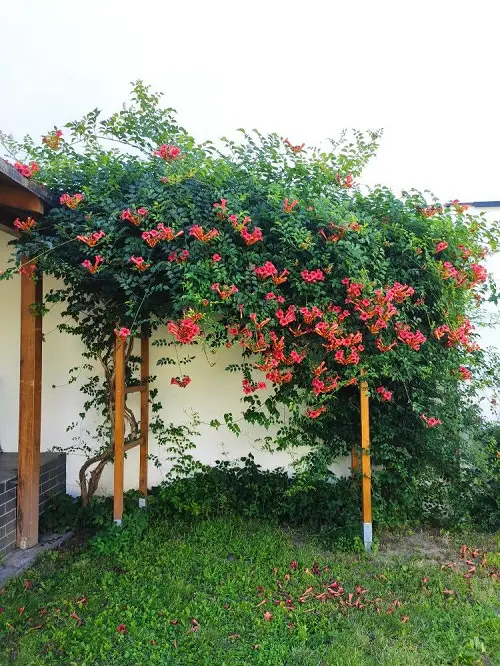
Botanical Name: Campsis radicans
USDA Zones: 4-10
With trumpet-shaped fiery red blooms that attract hummingbirds, this deciduous woody vine tolerates soil that lacks nutrients. It grows easily, adapts to sandy, clay, or rocky soil, and is a nitrogen fixer.
This vine develops a deep root system, which is why it doesn’t need regular watering and can flourish even if the soil around it lacks essential nutrients for plant growth.
2. Virginia Creeper
Botanical Name: Parthenocissus quinquefolia
USDA Zones: 3-10
Virginia Creeper is a fast-spreading winter flowering climber with stunning red foliage in the fall. This hardy vine has an extensive root system that allows it to outgrow other plants in the same soil.
Relatively drought-tolerant, this sun-loving vine may produce excess foliage in rich soil but blooms well in poor mediums, including sandy, clay, and loamy soil.
3. Beach Morning Glory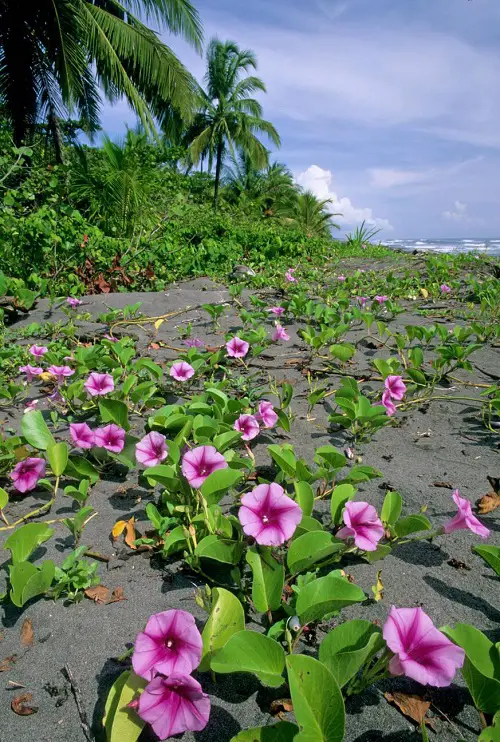
Botanical Name: Ipomoea pes-caprae
USDA Zones: 2-11
This one or any other morning glory type, they all actually “prefer” soil that is loose and not very nutrient rich to produce bell-shaped flowers in different hues and are great for covering walls and surfaces. While they thrive in dry, poor soil, they do require intermittent watering and well-drained soil to bloom better.
Any fertilizers or organic-rich supplements in excess inhibit flowering in these day bloomers.
4. Rangoon Creeper
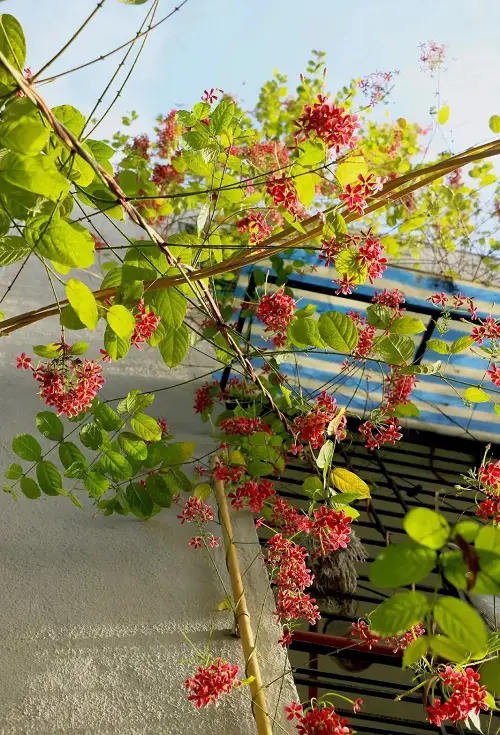
Botanical Name: Combretum indicum
USDA Zones: 9b-11
This vigorous vine has highly fragrant, star-shaped flowers that change color from white to pink to red as they mature. Rangoon Creeper also prefers less nutrients and sandy soil, so it can focus on blooming rather than excessive foliage growth.
It is drought-tolerant, making it an excellent choice for low-maintenance gardens in hot climates.
5. Wisteria
Botanical Name: Wisteria sinensis
USDA Zones: 5-9
There is one nitrogen-fixer on our list of vines that thrive in poor soil: Wisteria. It is a fast grower and deer-resistant deciduous vine! It produces drooping clusters of lilac blooms, but it needs pruning now and then to keep it tame and focus on flowering.
However, it cannot tolerate wet feet and needs good soil drainage.
6. Clematis
Botanical Name: Clematis
USDA Zones: 4-10
Clematis blooms best in moist, organic-rich, well-draining soil but can tolerate most soil types. With ample sun and afternoon shade, it produces colorful flowers from spring through fall.
Depending on the cultivar, they can tolerate cold winters and hot summers. Here are the best varieties you can grow.
7. Passionflower

Botanical Name: Passiflora incarnata
USDA Zones: 6-10
This bees and butterflies magnet is a hardy vine with lovely flowers in shades of purple and white. Passionflower is an incredibly resilient vine that can survive in many different kinds of well-draining soil, especially those with poor nutrient profiles.
Such a growing medium enables this perennial to focus on blooms rather than foliage. Watch out, though; it can grow up to 20-30 feet tall!
8. Bittersweet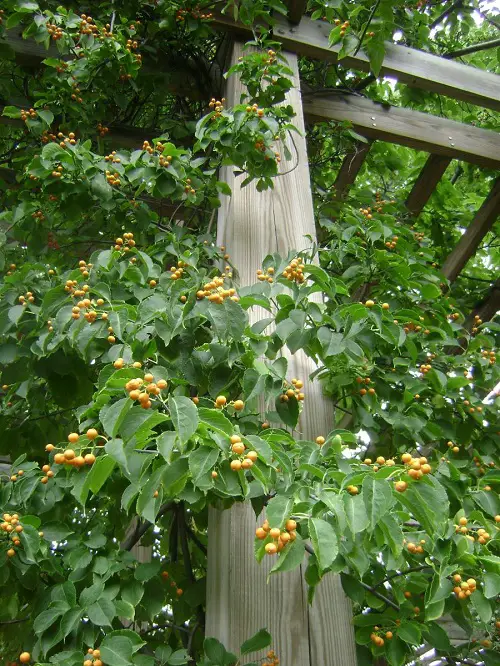
Botanical Name: Celastrus scandens
USDA Zones: 3-8
Bittersweet is a deciduous vine with green-white flowers that turn into pretty little orange berries in the fall. These berries are only edible to songbirds, pheasants, fox squirrels, and other fauna, not humans!
With a root system that allows them to access water and nutrients from the depths, bittersweet is relatively drought-tolerant and a super-fast grower! It quickly spreads and dominates even the poorest soil.
9. Dutchman’s Pipe
Botanical Name: Aristolochia macrophylla
USDA Zones: 4-8
Dutchman’s Pipe is another vigorous grower that tolerates versatile soil conditions. With beautiful heart-shaped leaves and pipe-shaped flowers, it thrives in well-drained, moist soil but, thanks to its large root system, grows undeterred in even slightly dry soil.
Its extensive roots allow it to absorb moisture and nutrients effectively.
10. Coral Vine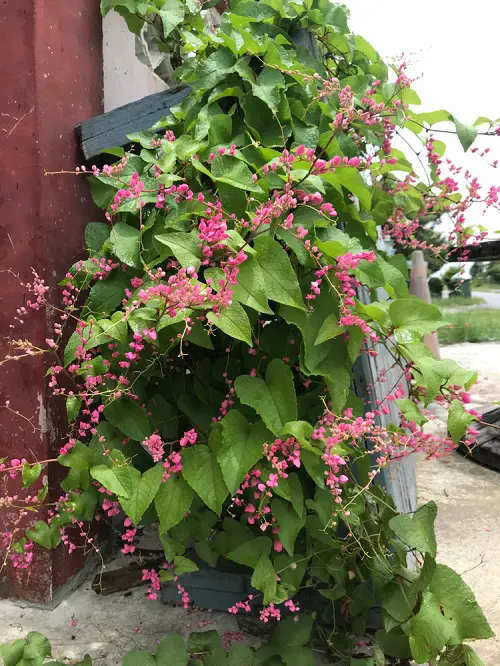
Botanical Name: Antigonon leptopus
USDA Zones: 9-11
Also called the Mexican Creeper, this fast-grower has pretty little pink flowers that bloom from summer to fall and is famously used to decorate fences and trellises. Its strong roots absorb all the nutrients it needs from the deeper soil layers.
Adapting well to different light conditions and poor soil, this climber is highly invasive.
11. Silver Lace Vine
(check image, most show abundant clusters of white flowers, not like this)
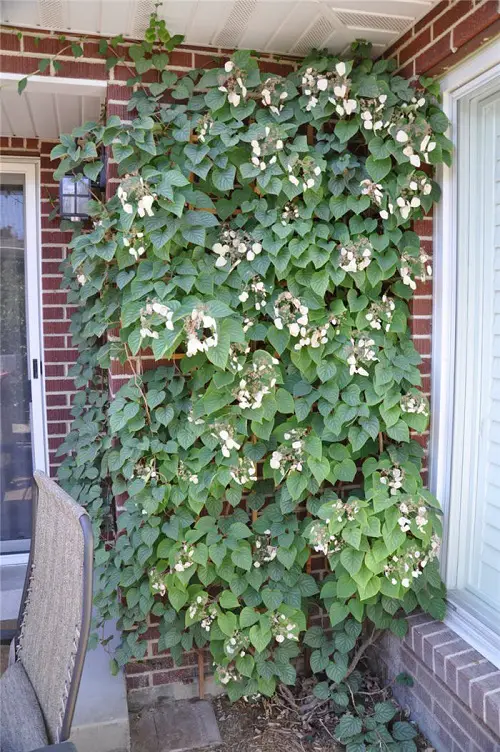
Botanical Name: Polygonum aubertii
USDA Zones: 4-9
This vigorous deciduous vine is highly invasive, quickly colonizing other vegetation, including tall trees! It produces dreamy clusters of fragrant white and pink blossoms and green heart-shaped leaves. Despite its beauty, remember not to plant it where native species try to survive, as it can outcompete other plants for available resources.
It thrives in poor soil with very little water requirements. Don’t forget to prune dead growth around spring and cut it down in winter so it remains in control.
12. Moonflower
Botanical Name: Ipomoea alba
USDA Zones: 9-10
Moonflower gets its name from fragrant white blooms that open at dusk and bloom through the night. A relative of the resilient morning glory, this sun-loving tender climber also does well in sandy or loamy, well-draining soils.
Easy to maintain, this beautiful vine can also colonize other native species once naturalized. It uses other plants to climb and often forms a dense canopy, cutting out light and nutrients essential for other vegetation.
13. Cypress Vine
Botanical Name: Ipomoea quamoclit
USDA Zones: 7-11
This fernlike vine grows well in poor sandy or loamy soil with average nutrition but cannot tolerate wet feet! It is a delicate, feathery vine with small, star-shaped scarlet flowers and a robust root system. While somewhat invasive, it doesn’t become a threat to native species but is toxic to dogs, cats, and horses.
14. Cat’s Claw Vine
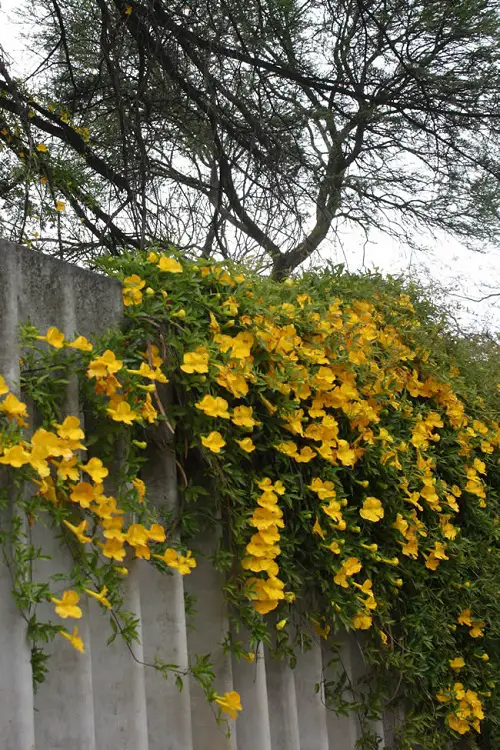
Botanical Name: Dolichandra unguis-cati
USDA Zones: 8-12
Named after its claw-like tendrils, this vine clings well to surfaces and displays large, showy, bell-shaped yellow flowers and thick foliage that are efficient in covering walls or fences.
However, with robust roots growing rapidly and strong-gripped tendrils, it can invade native vegetation and colonize even disturbed areas, creating a blanket of foliage over other plants, which is why it should be pruned regularly.
15. Smilax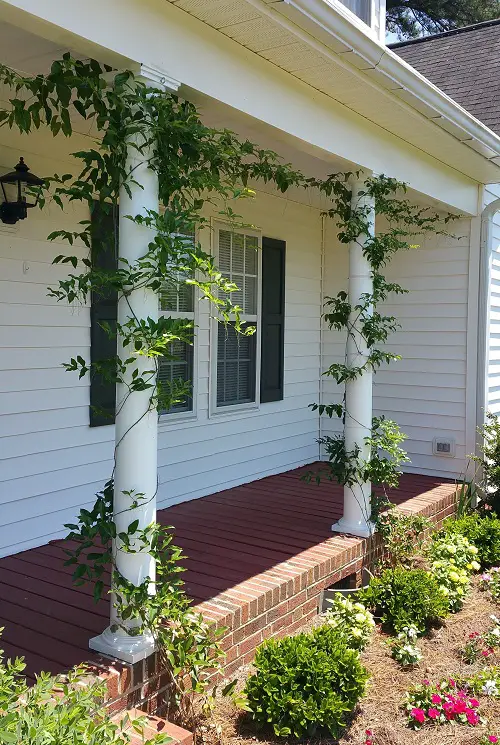
Botanical Name: Smilax spp.
USDA Zones: 7-9
Smilax is a fast-growing perennial climber with glossy green leaves and small, greenish flowers. This vine can be used as a ground cover or to climb structures, providing lush, dense foliage. Its hardy nature and deep root system allow it to access nutrients and moisture from the depths, ensuring healthy growth in well-draining sandy and loamy soil.
Interestingly, its root extracts are used to flavor beverages, ice creams, and confectionaries and possess anti-inflammatory properties.
16. Akebia

Botanical Name: Akebia quinata
USDA Zones: 7-9
You may know Akebia as Chocolate Vine. Akebia produces fragrant, chocolate-scented flowers and purple fruit. This vine is shade and drought-tolerant and has extensive roots that run deep, deriving nutrients even from poor soil.
But to make it bloom, you need to make sure that the growing medium is at least well-draining and has a lot of organic matter.
17. Bougainvillea

Botanical Name: Bougainvillea spp.
USDA Zones: 10-11
Bougainvillea is a hardy climber with a spectacular display of colorful bracts ranging from magenta to purple, red, orange, white, and yellow. These vines love sunshine and well-draining sandy loam soil. Depending on the variety, it can climb or be used as ground cover, grown as bonsai, or even garden hedges.
It blooms best in poor soil as long as the soil doesn’t retain moisture and gets too wet.
18. Dragon Fruit
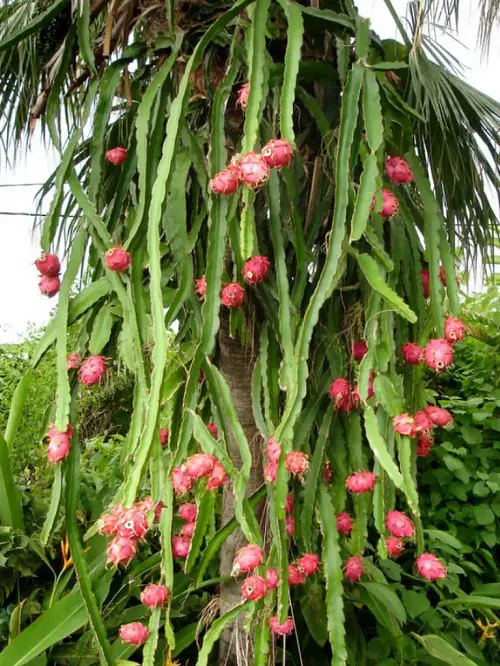
Botanical Name: Hylocereus spp.
USDA Zones: 10-11
Dragonfruit is a large cactus vine known for its cascading foliage and crunchy red fruits with seedy white flesh. It usually needs airy soil mixes similar to cacti; given the hardy nature of its native terrain, it’s really resilient and grows well in poor-quality soil.
19. Black-eyed Susan Vine
Botanical Name: Thunbergia alata
USDA Zones: 10-11
Black-eyed Susans are easy to grow and sun-loving climbers with beautiful tubular yellow to red blooms. While they thrive in rich, moist, well-drained soil, they are pretty adaptable and can tolerate poor soil—as long as it is not waterlogged.
So, no matter your soil type, we’re sure you’ll find the vine meant for you with this guide. Since many of them are invasive or, we say, resilient, ensure you plant them only where they cannot disrupt your existing vegetation.


